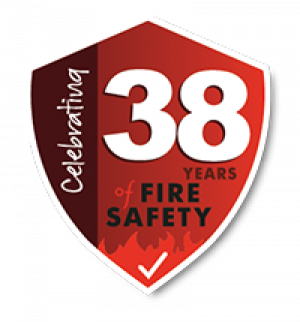How Often Should a Fire Extinguisher be Serviced?
1st Feb 2018

As a business owner, you’re responsible for the safety of your building, employees and visitors. This includes the provision of adequate fire safety equipment throughout the building. However, simply providing the equipment for firefighting and protection is not enough. You have to routinely inspect and maintain the equipment to ensure that it will function correctly in an emergency. These requirements are set out in the Regulatory Reform (Fire Safety) Order 2005.
With these requirements in mind, how often should you have your fire extinguisher serviced and what kind of service?
Every 12 months you must have your fire extinguishers serviced
Regular Visual Inspections (Once A Month)
Believe it or not, you are required to regularly check the condition of your fire extinguishers:
“Regular visual inspections of all portable fire extinguishers [must] be carried out by the user or user’s representative. The frequency of inspections […] should be not less than monthly and, when circumstances require, inspections should be carried out more frequently”
Water, foam, co2, wet chemical and powder fire extinguishers should be visually checked every month. These monthly checks are quick, easy to do and shouldn’t take up too much of your time. However, they quickly and efficiently identify potential issues in your fire protection equipment and can save lives, the building and the business.
A monthly fire extinguisher inspection comprises of a quick visual check of the extinguisher, its pressure gauge, headcap pin and seal. This is to identify any damage, loss of pressure or tampering. Finally, you should ensure that the extinguisher is located in its designated place on a wall bracket or extinguisher stand, and the extinguisher and usage instruction is easily visible.
Basic Service (Once A Year)
You must have your fire extinguishers serviced, every 12 months – this is what’s known as a “basic service” and needs to be done in accordance with BS 5036-3. This service is best done by a third party accredited fire extinguisher technician, with the correct tools, training and experience.
What specific steps are needed depends on the kind of extinguisher being serviced, as well as its age. Typically the technician will change the headcap seal, check the correct operation of the headcap safety pin, test the pressure gauge, and change any O rings in the junction of the valve and hose or horn. A visual check of the condition of the extinguisher and instruction label completes the job. Finally the technician will complete the maintenance label which carries the service history of the extinguisher.
DOWNLOAD OUR FREE MONTHLY FIRE EXTINGUISHER CHECKLIST HERE.
Extended Service
Extended servicing is done every 5 years for water, foam, powder, and wet chemical extinguishers. Note: CO2 extinguishers have different regulations (outlined below). Just like the annual basic service, this is best done by a trained and accredited technician, with the knowledge and experience to service an extinguisher correctly, safely and reliably.
Once again, the extended service goes through a detailed and in-depth look at everything included in the basic service, to a meticulous standard. Next, the extinguisher is discharged, with particular attention paid to the pattern, distance and duration of the discharged fire suppressant to ensure it is within specification.
The extinguisher’s valves are checked and overhauled. The interior is inspected to ensure that the lining is intact and there is no corrosion. The headcap O ring is replaced and the headcap assembly reseated to ensure that the valve will hold pressure. Next the extinguisher is re-filled and pressurised to specification and checked for leaks.
CO2 extinguishers are high-pressure vessels – much higher pressure than other fire extinguishers. Due to this, they’re subject to slightly different regulations and require different servicing than others. A CO2 extinguisher requires an extended service every 10 years and is called an overhaul.
The primary valve is replaced for a fresh one and the extinguisher body is hydrostatically pressure tested to check for stretching, cracking or bulging, which would otherwise be dangerous when re-filled. This involves the extinguisher being sent to an accredited service centre.
End Of Life
Providing that the fire extinguisher continues to pass inspections and can be serviced, there is no limit to how old a fire extinguisher can be. However, after a while replacement parts are no longer available, manufacturing standards change, and it becomes harder to service economically.
Because of the current environmental requirements regarding discharging of contents, and British Standard requirements regarding refilling, many extinguishers are now simply replaced with a new one when they are due an extended service or refill after use.
Do you need to arrange a service for your Fire Extinguishers? Contact us today.





